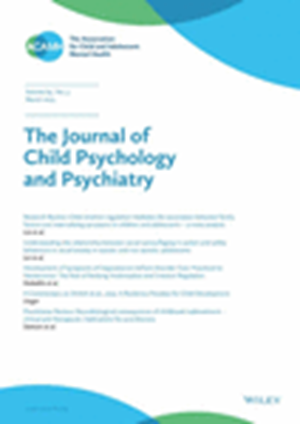感觉性听觉亢进是青春期焦虑的预测因子。
IF 7
1区 医学
Q1 PSYCHIATRY
引用次数: 0
摘要
背景越来越多的儿童在青春期早期到中期表现出焦虑。在从小学到中学(11岁)过渡期间及早发现风险,可以加强以家庭或学校为基础的干预措施。虽然已知的青少年焦虑的预测因素提供了一些见解,但仍需要识别和了解其他风险因素。听觉亢进(对声音的厌恶敏感性)与儿童和成人的焦虑相关,因此是纵向的候选危险因素。方法:我们利用雅芳父母与儿童纵向研究(ALSPAC, n = 6621)的数据,探讨听觉过度敏感的预测潜力。11岁时的听觉亢进用一个单一的问题进行评估,而焦虑和相关的情绪问题则在13岁、16岁时通过力量和困难问卷(SDQ-E)的情绪子量表和纵向轨迹(4-16岁)进行评估。结果耳鸣对13、16岁儿童焦虑有显著预测作用。即使考虑到先前存在的焦虑/情绪问题、自闭症特征和其他神经多样性特征(多动症、阅读障碍、运动障碍),这种预测效应在13岁时仍然存在。16岁时也出现了类似的模式,尽管不那么明显。当测试先前确定的四种情绪问题的童年轨迹时,听觉亢进预测持续与减少的轨迹(两种情况下,学龄前焦虑已经很高)比从低轨迹增加(两种情况下,学龄前焦虑很低)更可靠。额外的探索性分析发现,听觉过敏与SDQ-E中与恐惧、担忧和紧张相关的项目关系最为密切;仍然可以预测25岁时的SDQ-E分数,但不能预测成人广泛性焦虑症、重度抑郁症或自杀性自残。综上所述,我们的研究结果表明,在11岁时评估听觉亢进可以为青春期焦虑的恶化和维持提供额外的预测性见解。本文章由计算机程序翻译,如有差异,请以英文原文为准。
Sensory hyperacusis as a predictor of anxiety in adolescence.
BACKGROUND
An increasing number of children report anxiety in early to mid-adolescence. Early identification of risk during the transition from primary to secondary schools (age 11) could enhance family- or school-based interventions. While known predictors of adolescent anxiety provide some insight, there is a need to identify and understand additional risk factors. Hyperacusis (aversive sensitivity to sound) is correlated with anxiety in children and adults and thus a candidate risk factor longitudinally.
METHODS
We explored the predictive potential of auditory hyperacusis using data from the Avon Longitudinal Study of Parents and Children (ALSPAC, n = 6,621). Hyperacusis at age 11 was assessed with a single question, while anxiety and related emotional problems were captured by the emotional subscale of the Strength and Difficulties Questionnaire (SDQ-E) at ages 13, 16 and through longitudinal trajectories (4-16 years).
RESULTS
Hyperacusis significantly predicted anxiety at ages 13 and 16. This predictive effect remained for age 13 even when accounting for pre-existing anxiety/emotional problems, autism traits and other neurodiversity characteristics (ADHD, dyslexia, dyspraxia). Similar, though less pronounced, patterns emerged at age 16. When testing the four previously identified childhood trajectories of emotional problems, hyperacusis predicted persistent versus decreasing trajectories (the two cases when preschool anxiety is already high) more reliably than increasing from low trajectories (the two cases when preschool anxiety is low). Additional exploratory analyses found that hyperacusis was most strongly associated with SDQ-E items related to fear, worry, and nervousness; still predicted SDQ-E scores at age 25, but not adult generalised anxiety disorder, major depressive disorder or suicidal self-harm.
CONCLUSIONS
Taken together, our findings suggest that assessing hyperacusis at age 11 can provide additional predictive insights into the exacerbation and maintenance of anxiety in adolescence.
求助全文
通过发布文献求助,成功后即可免费获取论文全文。
去求助
来源期刊
CiteScore
13.80
自引率
5.30%
发文量
169
审稿时长
1 months
期刊介绍:
The Journal of Child Psychology and Psychiatry (JCPP) is a highly regarded international publication that focuses on the fields of child and adolescent psychology and psychiatry. It is recognized for publishing top-tier, clinically relevant research across various disciplines related to these areas. JCPP has a broad global readership and covers a diverse range of topics, including:
Epidemiology: Studies on the prevalence and distribution of mental health issues in children and adolescents.
Diagnosis: Research on the identification and classification of childhood disorders.
Treatments: Psychotherapeutic and psychopharmacological interventions for child and adolescent mental health.
Behavior and Cognition: Studies on the behavioral and cognitive aspects of childhood disorders.
Neuroscience and Neurobiology: Research on the neural and biological underpinnings of child mental health.
Genetics: Genetic factors contributing to the development of childhood disorders.
JCPP serves as a platform for integrating empirical research, clinical studies, and high-quality reviews from diverse perspectives, theoretical viewpoints, and disciplines. This interdisciplinary approach is a key feature of the journal, as it fosters a comprehensive understanding of child and adolescent mental health.
The Journal of Child Psychology and Psychiatry is published 12 times a year and is affiliated with the Association for Child and Adolescent Mental Health (ACAMH), which supports the journal's mission to advance knowledge and practice in the field of child and adolescent mental health.

 求助内容:
求助内容: 应助结果提醒方式:
应助结果提醒方式:


